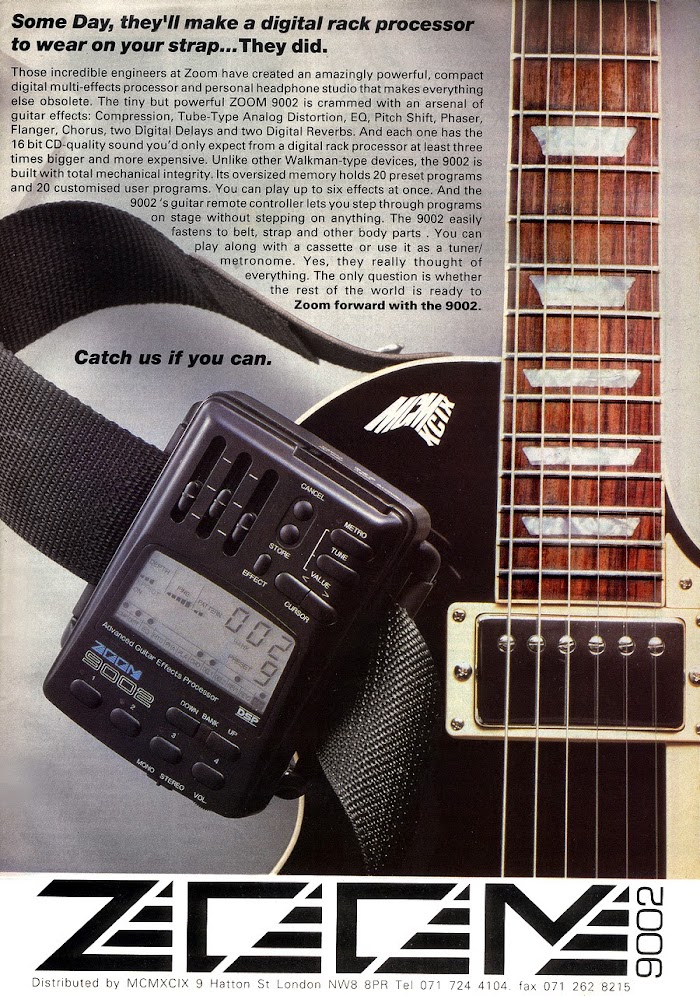
Original UK advert for the Zoom 9002 Processor - 1990.
Well, Zoom’s take on portability was different. They weren’t primarily aiming to make the guitar FX processor easier to transport to and from gigs – they were aiming to change the way in which it could be used on stage. They were looking to take what had previously been a remote device, placed either on the floor, atop an amp or in a rack, and essentially make it part of the instrument. If the unit was small enough, it could be mounted on the guitar strap, with an additional push-button remote control mounted on the body of the guitar itself. Everything would be literally at the guitarist’s fingertips – as was the case for keyboard players.
So, enter the Zoom 9002, conforming to all of the above, and in theoretical terms, an ingenious concept. In practice, however, the flaws in the plan started to show. Firstly, even though the 9002 represented a revolutionary downsizing in bulk as compared with a standard processor, it still suffered from the logistical paraphernalia of a standard guitar setup. Namely, the leads and connections, far from being hived off on the stage floor or round the back of a rack, were actually being pulled up around the guitar, and into the guitarist’s way.
In his review of the 9002 for Guitarist Magazine in 1990, Eddie Allen said:
“Remember, the guitar lead – or transmitter cable if you’re using one – will have a jack plug on the end, and with the Zoom’s output also connected there will always be two jacks and two cables coming out, in effect almost doubling the unit’s bulk.”
He then went on to talk about the hassle of controlling both this cabling and the additional cable from the remote unit, concluding:
“Tried it once, didn’t like it.”
I met Eddie in the early ‘90s and he was like a microcosm of the rock guitar market. His opinions really counted, because he encapsulated the mindset of the guitarists these companies were trying to sell to.
SOUND AND CAPABILITY
But size wasn’t everything, and the Zoom 9002 was marketed on a far broader spectrum of advantages. Firstly, there was a very strong focus on the quality of the unit’s effects, and secondly, there was always a reference to the 9002’s capability as a stand-alone practice/headphone amp. Both very significant selling points, but did they stand up to scrutiny?…
The effects included were: Compressor, Distortion (analogue, valve/tube-type), Equaliser, Pitch-Shifter, Chorus, Flanger, Phaser, Digital Reverb and Digital Delay. There were two separate variants of both the reverb and the delay. Sound quality was cited as in keeping with larger rack units, and up to six of the effects could be used simultaneously. The architecture was 16-bit, so there was inevitably going to be the potential for good clarity and fidelity in the delay and reverb. And this was indeed the case. There was, however (as you might expect given the era in which it was developed), a very ‘80s feel to the 9002’s sound. That highly processed but (to my ears) slightly stifled tone you’d hear on so many late ‘80s commercial productions really characterised the 9002. In its day, that was a big selling point, but as time went on, guitarists would come to want something more natural and earthy.
The Zoom 9002’s original price in the UK was £349. That was extremely competitive – in fact it was quite unexpectedly cheap for something offering multi-FX at rack quality, at that time. Whether the quality really was indistinguishable from rack FX is debatable in my view, and I never felt the 9002 came close to my Boss ME-5 in terms of tonal beauty. But that said, the ME-5 was predominantly an analogue device, so there was always going to be more warmth and organic sympathy to its overall sound, plus it was more expensive than the 9002, and bigger. No one could really deny that the 9002 offered a lot for the price, and of course all taste is subjective. My personal preferences might mean nothing at all to someone else.
CONCLUSION
If guitarists had been attaching modded or de-bulked stomp boxes to their straps or guitars in the eighties, and controlling them on the fly, by hand, then the 9002 concept would have been ragingly viable. But the fact that they didn’t, told a story, and sent a clear message. Guitarists did not want extra contraptions and paraphernalia hanging around their necks at the dawn of the ‘90s.
I could say that setting aside the size thing, the 9002 was a great product, offering very good value for money in its day. But the problem was that you couldn’t really set aside the size. So many guitarists must have looked at this thing and simply not been able to take it seriously. Where, in all seriousness, were they going to put it, if the answer wasn’t: “On their strap”? And the answer definitely wasn’t: “On their strap”.
It’s interesting that the original UK ad for the 9002 concluded with…
“The only question is whether the rest of the world is ready to Zoom forward with the 9002."
The unit did sell, but in a general sense the world was not ready for this idea. It’s also notable that the advert omits the cabling from the depiction of the 9002 in situ, and neither does it show the remote control. I suspect that by the time this groundbreaking device got to market, its distributors, if not its manufacturers, were well aware that guitarists were going to find strap-mounting impractical in the real world. They wisely majored on its internal features and value as a sound processor. But so did every other multi-FX manufacturer, and very soon, £349 would become an average price, rather than an unusually low one. At that moment, the 9002 would effectively be killed off.

